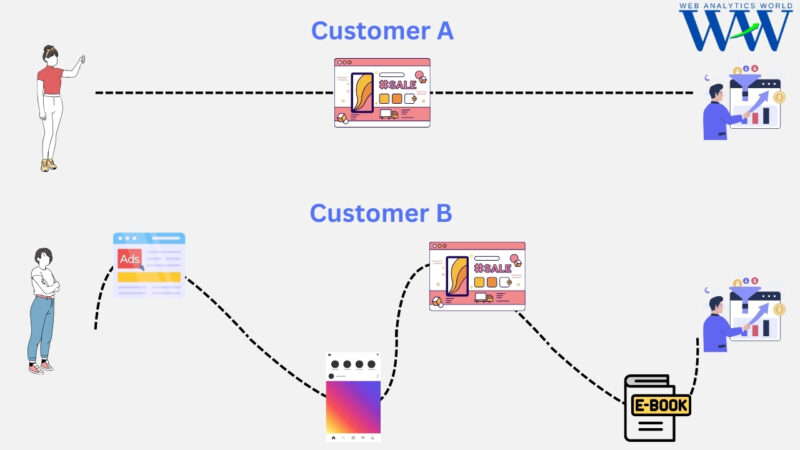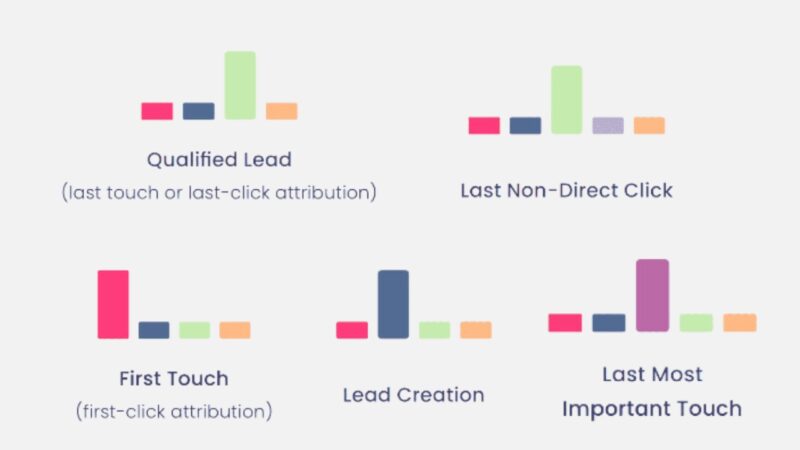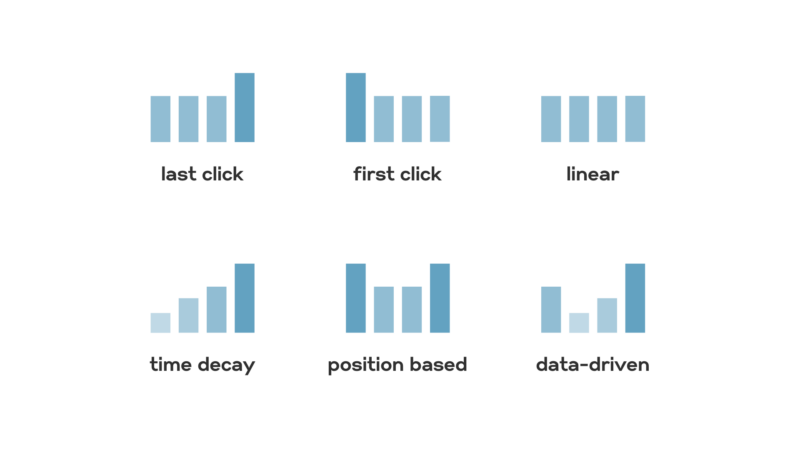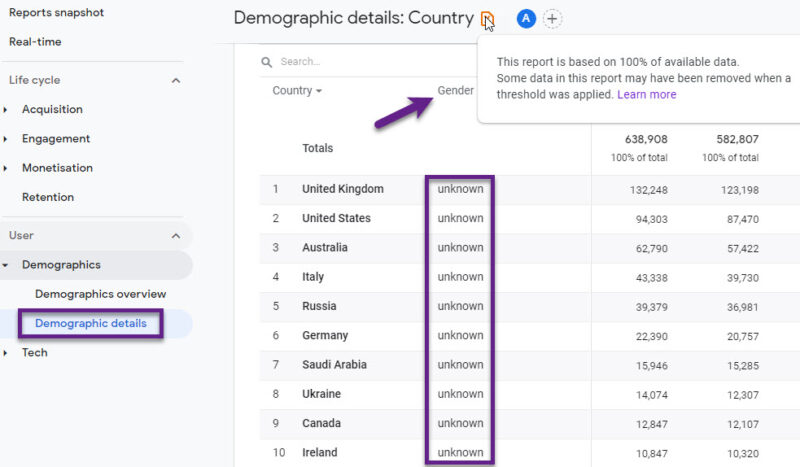Attribution modeling helps marketers analyze and assign credit to different marketing touchpoints throughout the customer journey, from initial search to purchase.
This approach helps identify which marketing efforts are most effective at driving leads through the sales funnel.
Multi-touch modeling distributes credit across various touchpoints, providing insights into how different marketing interactions influence the entire sales process.
Importance of Attribution Models in Digital Marketing
Attribution models are crucial in digital marketing because they help marketers running multiple campaigns across various platforms determine which PPC keywords, display ads, landing pages, and SEO efforts effectively generate leads.
These models provide a comprehensive view of each customer journey, from the initial interaction to the final purchase, allowing marketing teams to understand which strategies are driving conversions.
Example of Attribution

Consider two customers, A and B, who are both searching for a product your company offers.
Customer A quickly converts in one step because they knew what they wanted and your website delivered it. Simple and straightforward.
Customer B’s journey, however, is more complex. They first clicked on a display ad, then engaged with your brand on social media, visited your website via an organic search listing, downloaded an ebook, and finally reached out through live chat a week later before signing up for a demo.
As you can see, Customer B’s path involved multiple touchpoints over time. If you only credit the last touchpoint before the sale, you miss the influence of all the previous interactions that led to the purchase.
This example illustrates a multi-touch conversion route, which is increasingly common in today’s digital marketing landscape. Understanding which initial efforts successfully attract customers helps identify what draws them into the sales funnel. Similarly, models that highlight the final touch before conversion reveal which channels effectively drive buyers to complete a purchase.
Knowing the impact of each touchpoint helps optimize marketing strategies. If you know which interactions lead to conversions, you can enhance those channels with strong calls to action and prompts.
So, why is it important to understand single or last-touch versus multi-touch conversion routes? It saves money. As a marketer, you need to know how and when your campaigns drive conversions. Attribution modeling provides crucial data on which campaigns work, and which don’t, and where to allocate your budget for optimal conversion rates at key stages of the sales process.
Attribution modeling allows you to move beyond the “throw everything at the wall and see what sticks” approach. Instead, you can work smarter, leveraging ROI data to refine your marketing efforts.
Single-Touch vs Multi-Touch Attribution Models
Types of Attribution Models
Attribution models can vary widely, from AI-based software to tools like Facebook’s attribution tool and Google Analytics models. Generally, they are categorized into two main types: single-touch and multi-touch.
Single-Touch Models
Single-touch models assign credit to just one touchpoint in the customer journey, usually the first or the last interaction.
Common Single-Touch Models:
- First touch model (first-click attribution)
- Qualified lead model (last-click attribution)
- Lead creation model
- Last non-direct click model
- Last significant touch model
These models focus on either the initial interaction or the final action before purchase. While straightforward, they don’t account for the complexity of modern consumer behavior, where customers often interact with multiple channels before making a decision.
Limitations of Single-Touch Models
Single-touch models fail to capture the full customer journey. For example, a customer might see an Instagram ad, visit your website later, and finally purchase after clicking a Facebook ad. If you only credit one touchpoint, you miss the influence of the others. This approach overlooks the interconnected nature of customer interactions.
Multi-Touch Models
Multi-touch attribution models assign value to each touchpoint in the customer journey, reflecting its role in the buying process.
Common Multi-Touch Models:
- Linear attribution
- Time decay attribution
- U-shaped attribution
- W-shaped attribution
- Z-shaped attribution
In multi-touch models, each interaction is given an appropriate value based on its importance. For example, a customer spending $100 might have their journey valued as follows: $30 for the initial Instagram ad, $20 for visiting your Instagram account, $20 for browsing your website, and $30 for the Facebook ad that led to the purchase.
Advantages of Multi-Touch Models
Multi-touch models provide a more comprehensive view of the customer journey. They offer detailed insights into how each interaction contributes to the final purchase. Some models use predefined formulas to assign credit, while custom models allow for adjustments based on various factors, providing tailored insights for marketers.
Overall, multi-touch attribution offers richer insights than single-touch models, helping marketers understand and optimize the entire customer journey.
Single Touch Attribution Models

First Touch Model
First Touch Model (First-Click Attribution) This model assigns all credit to the initial interaction your business had with a customer before they made a purchase. It’s useful for identifying what catches new customers’ attention at the top of the funnel.
- Purpose: Identifies which marketing efforts generate initial interest.
- Example: A customer first clicks on a PPC ad. All credit for the eventual sale goes to this ad.
- Benefit: Helps understand the effectiveness of top-of-funnel strategies, which is especially important for businesses with longer sales cycles aiming to build brand advocates.
Qualified Lead Model (Last Touch)
Qualified Lead Model (Last-Click Attribution) This model gives all credit to the last interaction before the customer converts.
- Purpose: Identifies which touchpoint directly leads to conversion.
- Example: A customer visits a blog post and then calls your company. The blog post gets all the credit.
- Benefit: Useful for understanding which final interactions drive conversions, especially effective for businesses with shorter sales cycles.
Lead Creation Model
Lead Creation Model This model focuses on the interaction where a prospect becomes a qualified lead.
- Purpose: Pinpoints the critical touchpoint where a prospect becomes a lead.
- Example: A prospect fills out a form to download a whitepaper, becoming a lead. This interaction gets all the credit.
- Benefit: Helps identify effective lead generation tactics.
Last Non-Direct Click Attribution
Last Non-Direct Click Attribution This model credits the last non-direct touchpoint before the customer converts.
- Purpose: Focuses on the last indirect interaction leading to a sale.
- Example: A customer clicks on an email campaign link before purchasing. The email campaign gets all the credit.
- Benefit: Useful for understanding the impact of non-direct channels.
Last Most Important Touch Model
Last <Most Important Touch> Model This customizable model assigns all credit to the last touchpoint of a predetermined important channel.
- Purpose: Prioritizes a specific channel’s influence on conversions.
- Example: If you determine social media is crucial, the last social media interaction before purchase gets all the credit.
- Benefit: Allows focus on optimizing a specific marketing channel deemed most important.
These single-touch attribution models each provide unique insights into specific stages of the customer journey, helping marketers refine their strategies based on where they see the most significant impact.
Multi-Touch Attribution Models
Linear Attribution
This model distributes credit equally among all touchpoints in the customer journey.
- Example: If there are 3 touchpoints, each gets 33.33% of the credit.
- Benefit: Provides a balanced view of all interactions, recognizing the contribution of each touchpoint.
Time Decay Attribution
Similar to linear attribution, but gives more credit to the most recent touchpoints.
- Example: Recent interactions get a larger percentage of the credit, while earlier interactions get less.
- Benefit: Highlights the importance of interactions closer to the conversion point, useful for understanding the impact of recent engagements.
U-Shaped Attribution
This model assigns 40% of the credit to both the first interaction and the conversion point, with the remaining 20% spread among the other touchpoints.
- Example: The first interaction and the conversion point each get 40%, and the interactions in between share the remaining 20%.
- Benefit: Emphasizes the initial engagement and the conversion action, useful for tracking lead generation and initial interest.
W-Shaped Attribution
Credit is split among the first touch, last touch, and the qualified lead milestone.
- Example: Each of these three touchpoints gets 30% of the credit, with the remaining 10% divided among other interactions.
- Benefit: Focuses on key milestones in the customer journey, ideal for understanding critical points in lead conversion.
Z-Shaped Attribution
Gives credit to all touchpoints, with emphasis on the four most important ones.
- Example: The four main touchpoints get 22.5% each, and the remaining 10% is divided among the other interactions.
- Benefit: Offers a comprehensive view, highlighting key interactions while still acknowledging other touchpoints in the journey.
Choosing the Right Attribution Model for Your Business

Tailor Your Attribution Model to Your Marketing Strategy
No two brands have the same marketing strategy, so selecting the right attribution model is crucial. For high-value goods like cars with longer sales cycles, a comprehensive model is necessary. This model should track:
- Initial brand awareness
- Points where customers drop off
- Reasons for returning to the site
- Factors influencing the final purchase decision
Determine Your End Goal
Before choosing an attribution model, define your end goal. Do you want a broad overview of how different campaigns work together to push customers through the buying funnel? Or do you need detailed insights into which touchpoints contribute most to conversions?
For example, you might want to test if customers first discover your brand through organic search and later return via targeted Instagram ads. Alternatively, you might want to know precisely which touchpoints are most effective, helping you optimize your marketing strategy accordingly.
Consider In-House Data Science Capabilities
Advanced attribution models often require a data scientist to fine-tune credit allocation. If your organization lacks data science resources, a simpler attribution model may be more practical.




